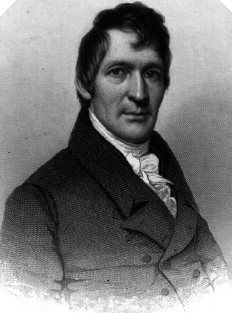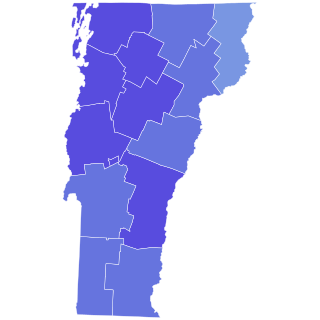
The 10th United States Congress was a meeting of the legislative branch of the United States federal government, consisting of the Senate and the House of Representatives. It met in Washington, D.C., from March 4, 1807, to March 4, 1809, during the seventh and eighth years of Thomas Jefferson's presidency. The apportionment of seats in the House of Representatives was based on the 1800 census; both chambers had an overwhelming Democratic-Republican majority.

Isaac Tichenor was an American lawyer and politician. He served as the third and fifth governor of Vermont and United States Senator from Vermont.

The 1808–09 United States House of Representatives elections were held on various dates in various states between April 26, 1808, and May 5, 1809. Each state set its own date for its elections to the House of Representatives before the first session of the 11th United States Congress convened on May 22, 1809. They coincided with James Madison being elected as president. Elections were held for all 142 seats, representing 17 states.

The 1806–07 United States House of Representatives elections were held on various dates in various states between April 29, 1806 and August 4, 1807. Each state set its own date for its elections to the House of Representatives before the first session of the 10th United States Congress convened on October 26, 1807. They occurred during Thomas Jefferson's second term. Elections were held for all 142 seats, representing 17 states.

Israel Smith was an American lawyer and politician. He held a wide variety of positions in the state of Vermont, including as a member of the United States House of Representatives, a member of the United States Senate, the fourth governor of Vermont.

William Adams Palmer was an American lawyer and politician. A prominent of the Anti-Masonic Party in the 1830s, he was most notable for his service as a United States Senator from Vermont (1818–1825) and the 13th governor of Vermont (1831–1835).

Hiram Bell was an American politician who was a U.S. Representative from the Ohio's Third Congressional District.

Cornelius Peter Van Ness was an American politician and diplomat who served as the tenth governor of Vermont from 1823 to 1826 and Envoy Extraordinary and Minister Plenipotentiary to the Kingdom of Spain from 1829 to 1836. Van Ness was a Democratic-Republican and later a Democrat.
William Cahoon was an American judge and politician. He served as a U.S. representative from Vermont for two terms from 1829 to 1833.

The 1808–09 United States Senate elections were held on various dates in various states, coinciding with the 1808 presidential election. As these U.S. Senate elections were prior to the ratification of the Seventeenth Amendment in 1913, senators were chosen by state legislatures. Senators were elected over a wide range of time throughout 1808 and 1809, and a seat may have been filled months late or remained vacant due to legislative deadlock. In these elections, terms were up for the senators in Class 1.

The 2010 United States House of Representatives election in Vermont was held on November 2, 2010 and determined who would represent the state of Vermont in the United States House of Representatives. Democratic Congressman Peter Welch decided to run for a third term in Congress, facing Republican Paul D. Beaudry and two independent candidates. Welch won over his three opponents by a healthy margin, which allowed him to represent Vermont in the 112th Congress.

Vermont elected its members September 7, 1824. Congressional districts were re-established in Vermont for the 1824 election. Vermont had used an at-large district 1812-1818 and 1822. A majority was required for election, which was not met in the 1st district, necessitating a second election December 6, 1824.
A special election was held in Vermont's 1st congressional district on September 6, 1808, to fill a vacancy caused by the resignation of James Witherell (DR) on May 1 of the same year, to accept a position as judge of the Supreme Court of Michigan Territory.

The 1996 Vermont gubernatorial election took place on November 5, 1996. Incumbent Democrat Howard Dean ran successfully for re-election to a third full term as Governor of Vermont, defeating Republican nominee John L. Gropper.

The 1988 Vermont gubernatorial election took place on November 8, 1988. Incumbent Democrat Madeleine Kunin ran successfully for re-election to a third term as Governor of Vermont, defeating Republican candidate Michael Bernhardt.

The 2016 United States House of Representatives election in Vermont was held on November 8, 2016, to elect the U.S. representative from the state of Vermont from Vermont's at-large congressional district. The election coincided with the 2016 U.S. presidential election, as well as other elections to the House of Representatives, elections to the United States Senate and various state and local elections. The primaries were held on August 9.

The 1808 United States presidential election in Vermont took place between November 4 and December 7, 1808, as part of the 1808 United States presidential election. The state legislature chose six representatives, or electors to the Electoral College, who voted for President and Vice President.

The 1892 United States presidential election in New Hampshire took place on November 8, 1892, as part of the 1892 United States presidential election. Voters chose four representatives, or electors to the Electoral College, who voted for president and vice president.

The 1808 United States presidential election in Connecticut took place between November 4 and December 7, 1808, as part of the 1808 United States presidential election. The state legislature chose nine representatives, or electors to the Electoral College, who voted for President and Vice President.
















